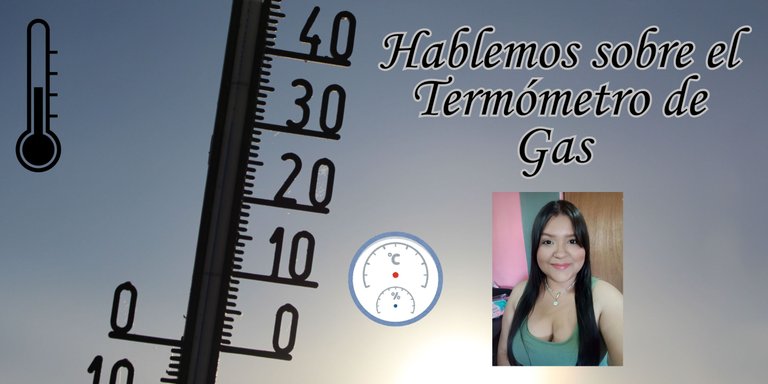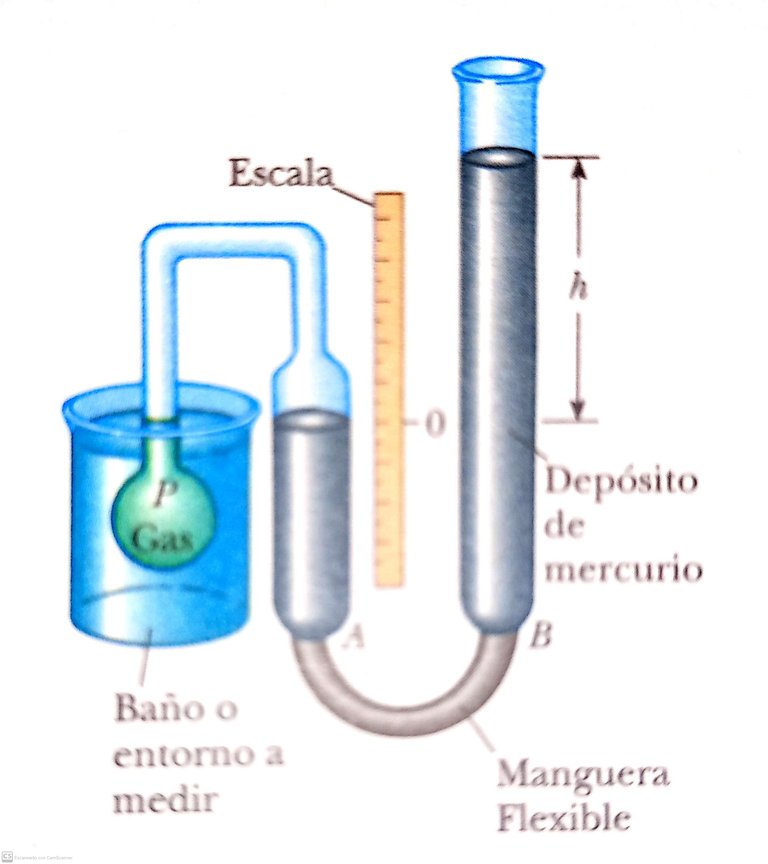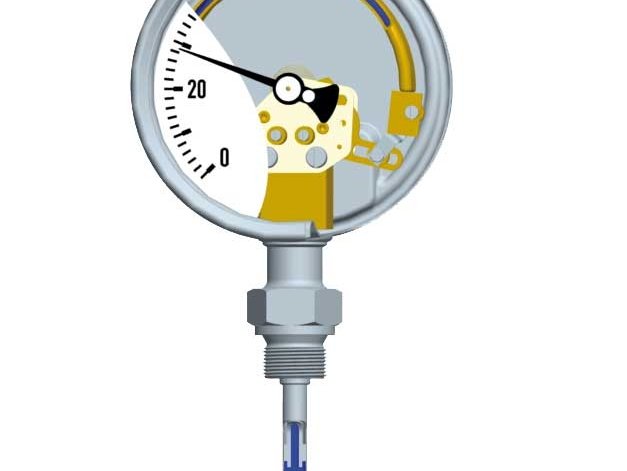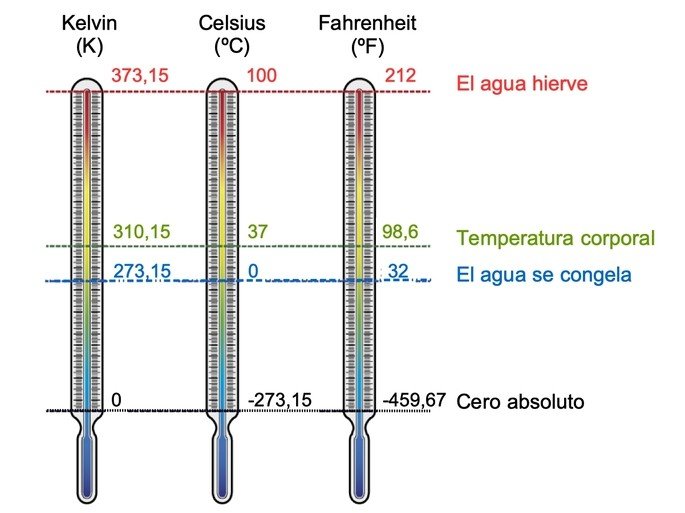Hello dear hive community! 😉
¡Hola querida comunidad de hive! 😉
En nuestra publicación anterior resaltamos que el termómetro de alcohol y mercurio no es tan preciso para realizar algunas medidas por eso se requiere de un termómetro más universal. Hoy hablaremos del termómetro de gas de volumen constante.
In our previous publication we pointed out that the alcohol and mercury thermometer is not so accurate for some measurements and that is why a more universal thermometer is required. Today we will talk about the constant volume gas thermometer.

Imagen realizada con la página web de diseño gráfico y composición de imágenes Canva // Image made with the graphic design and image composition website Canva.
Un ejemplo de un termómetro de gas lo podemos observar en la imagen que se muestra a continuación. La propiedad física presente en este aparato, es la variación de presión de gas con un volumen fijo de gas con respecto a la temperatura. Cuando se creó este dispositivo fue calibrado de tal manera que los puntos de ebullición y congelación del agua quedaron de manera siguiente: Tenemos un punto A y un punto B, el frasco se sumerge en agua helada, en el punto B donde está el mercurio el mismo se sube o se baja teniendo como guía la columna A la cual está en el punto 0 de la escala. Entonces, es la altura h, la que muestra la diferencia entre los niveles de mercurio en el depósito B y la columna A, la cual es la presión del frasco a 0°C.
An example of a gas thermometer can be seen in the image shown below. The physical property present in this device is the variation of gas pressure with a fixed volume of gas with respect to temperature. When this device was created, it was calibrated in such a way that the boiling and freezing points of water were as follows: We have a point A and a point B, the flask is immersed in ice water, at point B where the mercury is the same is raised or lowered having as a guide the column A which is at the 0 point of the scale. Then, it is the height h, which shows the difference between the mercury levels in tank B and column A, which is the pressure of the flask at 0°C.

Fuente: Serway y Jewett (2005)
Para el punto de ebullición, se sumerge el frasco pero el punto B se reajustará hasta que la parte superior de la columna B esté en cero, esto asegura que el volumen del gas es igual que cuando el frasco se encontraba sumergido en agua helada. Dicho ajuste arrojó un valor para la presión del gas de 100°C.
Ahora bien, si se desea medir la temperatura de cualquier sustancia lo que se debe hacer es colocar el frasco de gas en contacto térmico con la sustancia a medir y se ajusta la sustancia que está en el depósito B hasta que la parte superior de la columna A esté en cero. La altura de de la columna de mercurio nos muestra la presión del gas, obviamente conociendo la presión y así podemos hallar la temperatura de la sustancia.
For the boiling point, the flask is immersed but point B will be readjusted until the top of column B is at zero, this ensures that the volume of gas is the same as when the flask was immersed in ice water. This adjustment yielded a value for the gas pressure of 100°C.
Now, if you want to measure the temperature of any substance, you must place the gas bottle in thermal contact with the substance to be measured and adjust the substance in tank B until the top of column A is at zero. The height of the mercury column shows us the pressure of the gas, obviously knowing the pressure and thus we can find the temperature of the substance.

Source
Pero, si suponemos que medimos las temperaturas con termómetros de gas que contienen diferentes gases a diversas presiones iniciales. No obstante, diferentes experimentos logran demostrar que las lecturas del termómetro son casi independientes del tipo de gas, pero con la particularidad de que la presión del gas debe ser baja y la temperatura esté por arriba del punto en el que el gas se licúa. Un aspecto en el que coinciden los termómetros que usan diferentes tipos de gas es que la apreciación mejora cuando se reduce la presión.
Sin embargo ocurre una situación bastante particular cuando se gráfica una recta de temperatura y la prolongamos hacia el lado negativo y es que en todos los casos, la presión es cero cuando la temperatura es -273.15 °C. Este valor comienza a jugar un papel primordial y es que se utiliza como base para la escala absoluta de temperatura que fija a -273.15 como el punto cero. A este valor se le conoce como cero absoluto y el tamaño de un grado en la escala absoluta se elige de manera igual que el grado en la escala Celsius, por tal motivo la conversión entre estas temperaturas es:
But, if we assume that we measure temperatures with gas thermometers containing different gases at various initial pressures. However, different experiments manage to demonstrate that the thermometer readings are almost independent of the type of gas, but with the particularity that the gas pressure must be low and the temperature must be above the point at which the gas liquefies. One aspect in which thermometers using different types of gas coincide is that the appreciation improves when the pressure is reduced.
However, a quite particular situation occurs when we plot a temperature line and extend it to the negative side, and in all cases, the pressure is zero when the temperature is -273.15 °C. This value begins to play an important role and is used as the basis for the absolute temperature scale that sets -273.15 as the zero point. This value is known as absolute zero and the size of a degree on the absolute scale is chosen in the same way as the degree on the Celsius scale, so the conversion between these temperatures is:
Dónde Tc es la temperatura Celsius y T es la temperatura absoluta.
Como los puntos de ebullición y congelación son muy difíciles de duplicar hablando de una manera experimental, se adoptó dos nuevos puntos fijos por el Comité Internacional de Pesas y Medidas. El primer aspecto a considerar es el cero absoluto, la segunda temperatura de referencia que se consideró fue el punto triple del agua, que es una combinación única de temperatura y presión en la que el agua líquida, agua en estado gaseosa y agua sólida (hielo) pueden coexistir en equilibrio. Dicho punto se presenta a una temperatura de 0,01°C y una presión de 4.58 mm de mercurio. En la nueva escala de temperatura la cual se denomina Kelvin se fijó el punto triple como 273.16 Kelvin que se abrevia como 273.16 K. Dicha selección se realizó de esa manera para que la escala anterior, es decir, la escala de temperatura absoluta, basada en los puntos de congelación y ebullición pudieran concordar cercanamente con la nueva escala basada en el punto triple. Está nueva escala de temperatura absoluta (también llamada Kelvin) emplea el kelvin como unidad en SI de temperatura absoluta, dónde se define el kelvin como 1/273.16 de la diferencia entre el cero absoluto y la temperatura del punto triple del agua.
Where Tc is the Celsius temperature and T is the absolute temperature.
As the boiling and freezing points are very difficult to duplicate experimentally, two new fixed points were adopted by the International Committee of Weights and Measures. The first aspect to be considered is absolute zero, the second reference temperature to be considered was the triple point of water, which is a unique combination of temperature and pressure at which liquid water, gaseous water and solid water (ice) can coexist in equilibrium. This point occurs at a temperature of 0.01°C and a pressure of 4.58 mm of mercury. In the new temperature scale which is called Kelvin, the triple point was set as 273.16 Kelvin which is abbreviated as 273.16 K. This selection was made so that the previous scale, i.e. the absolute temperature scale, based on the freezing and boiling points could agree closely with the new scale based on the triple point. This new absolute temperature scale (also called Kelvin) uses the kelvin as the SI unit of absolute temperature, where the kelvin is defined as 1/273.16 of the difference between absolute zero and the triple point temperature of water.

Source
Ya para despedirme espero que el tema sea del agrado de los lectores y deseo ver en los comentarios sus opiniones y aportes significativos que ayuden a la ampliación del tema y que genere un debate crítico y enriquecedor para la satisfactoria divulgación del conocimiento científico
In closing, I hope that the topic is to the readers' liking and I hope to see in the comments your opinions and significant contributions that will help to broaden the topic and generate a critical and enriching debate for the satisfactory dissemination of scientific knowledge.
Referencias
Serway, R; Jewett J. (2005). Física para Ciencias e Ingeniería. Editorial Thomson: México.
Zemansky, S. (2009). Física Universitaria Volumen II. México: Pearson Educación.
References
Serway, R; Jewett J. (2005). Physics for Science and Engineering. Editorial Thomson: México.
Zemansky, S. (2009). Physics Volume II. Mexico: Pearson Educación.
Translator Deepl


Posted Using InLeo Alpha
~~~ embed:1872434694291353926?t=9AonqGD9oWdCm-4cB3GHOg&s=19 twitter metadata:SUxvdmVQaHlzaWNhfHxodHRwczovL3R3aXR0ZXIuY29tL0lMb3ZlUGh5c2ljYS9zdGF0dXMvMTg3MjQzNDY5NDI5MTM1MzkyNnw= ~~~
Thanks for your contribution to the STEMsocial community. Feel free to join us on discord to get to know the rest of us!
Please consider delegating to the @stemsocial account (85% of the curation rewards are returned).
You may also include @stemsocial as a beneficiary of the rewards of this post to get a stronger support.